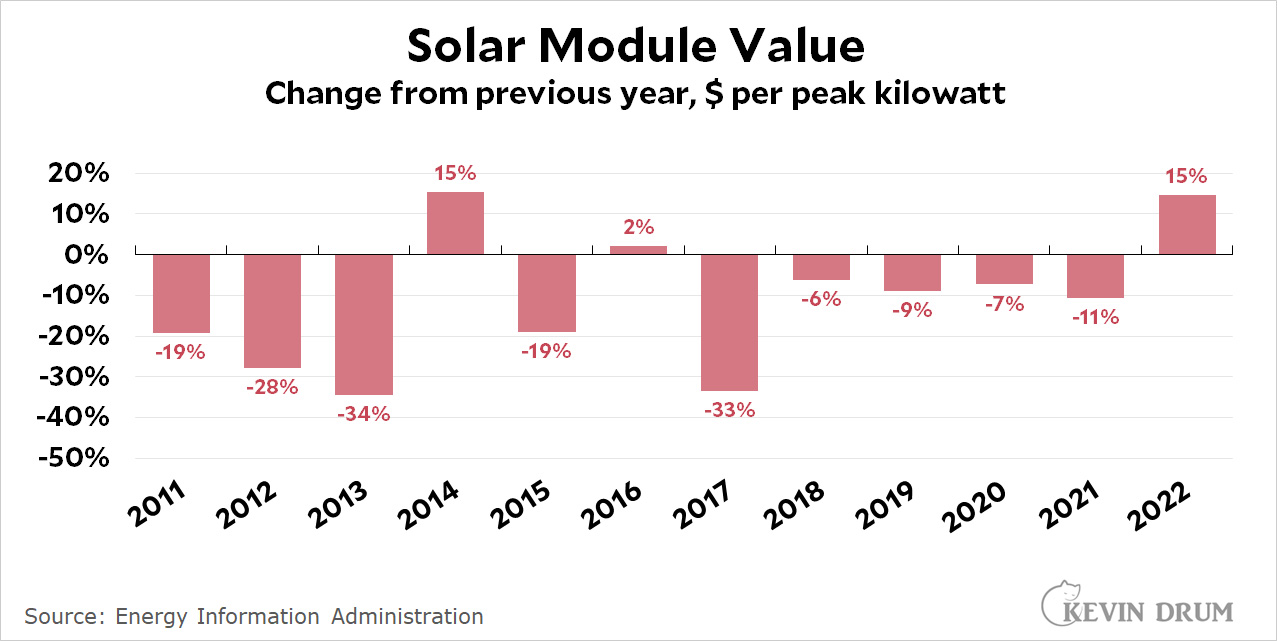The Energy Information Administration published its latest report on solar module shipments today, and the news for 2022 wasn't very good. Shipments of photovoltaic modules were up only 10%, much lower than in previous years:
 And for the first time in six years, the cost of photovoltaic modules increased. In 2022, modules cost 39 cents per kilowatt compared to 34 cents the previous year:
And for the first time in six years, the cost of photovoltaic modules increased. In 2022, modules cost 39 cents per kilowatt compared to 34 cents the previous year:
 The top states for shipments of solar modules were California, Texas, Florida, and South Carolina. That's some pretty woke energy policy from those three red states.
The top states for shipments of solar modules were California, Texas, Florida, and South Carolina. That's some pretty woke energy policy from those three red states.

Solar energy installations are down? How can this be? Not a week goes by without at least a few people showing up at my door to try to sell me on a new "solar system".
(I'm still holding out for one where Pluto is a planet.)
Well, if the installations were up, there wouldn't be any need to be going door-to-door trying to sell it 🙂
They aren't down - the change from the previous year is down. The amount of solar measured in the first chart is still up 10% from 2022.
Ah, the change in the rate of change -- the second derivative! When I teach calculus, I tell students that in the real world, any time you hear the second derivative mentioned, probably someone is trying to mislead you. (Or in any case, don't read too much into it.)
If they indeed have state-level incentives to install solar. Do they? Otherwise, solar is supposed to be (long-run) cheaper, right? Which would make it just pretty smart economic policy.
Whether it continues to make economic sense here in California remains to be seen - we have a new tariff in town which cuts the rate at which the utilities must buy-back excess power from rooftop solar, but retains "net zero" near as I can tell, and there appear to be other, various charges on the horizon...
Yes. It's the same phenomena that leads to Iowa being a leader in wind turbines. The state is deep red, but turbines make money and farmers like getting paid. I have a cousin who farms in NW Iowa, and he told me that a few years ago he made more from his turbines than from his crops and pigs.
This is USA only or global shipments and prices?
I'm thinking the reason why shipments were down in 2022 was the confluence of Biden extending the Trump solar tariffs in Feb 2022 and the expected expiration of the solar tax credit (until it was renewed as part of the Inflation Reduction Act.
KD's last post about this got me all wound up about how my state (NM, very high insolation) was beaten by ME (very low insolation) in terms of panel shipments.
So much so that I had an email conversation with my state rep (who helped author our current tax rebate for solar PV installs).
That led me off in search of numbers for actual generation, not installed panels.
Turns out that NM is doing fine - way, way ahead of ME by that metric.
KD's use of shipped panels as a proxy for generating capacity is wrong, because it ignores insolation. Put simply (and almost certainly incorrectly due to exaggeration), 1 300W panel in NM generates a LOT more power than the same panel in ME.
KD - you should stop doing this. You can get generation data here:
https://www.eia.gov/electricity/data/browser/#/topic/0?agg=2,0,1&fuel=0041&geo=vvvvvvvvvvvvo&sec=g&linechart=ELEC.GEN.SUN-US-99.A~&columnchart=ELEC.GEN.SUN-US-99.A&map=ELEC.GEN.SUN-US-99.A&freq=A&start=2001&end=2022&ctype=linechart<ype=pin&rtype=s&maptype=0&rse=0&pin=
Good point!
Also, +10 for "insolation"
Re: rick_jones: "If they indeed have state-level incentives to install solar. Do they?"
South Carolina has enacted a raft of alternative energy measures in the last few years and leaned on the utilities to be more friendly to customer solar installations. I think the tax credit for homeowner solar is 25%, with various complications on how much you can deduct per year. (But you get 10 years to use up the credit.) They are also encouraging commercial wind and solar. Consequently, there's quite a bit of solar to be seen now.
A good bit of this is a reaction to the recent nuclear reactors fiasco. The junior partner in this financial disaster was the Public Service Commission of SC (aka Santee Cooper). The Republicans frothed about selling it off, but that is politically impossible. So deep red SC still owns New Deal era Santee Cooper, one of the state's major utilities. Santee Cooper really seems to be working hard to rebuild trust and part of that entails making solar easier.
Anyway the nuclear fiasco really dashed the credibility of the utilities when they kept saying they just couldn't work out how to accommodate solar.